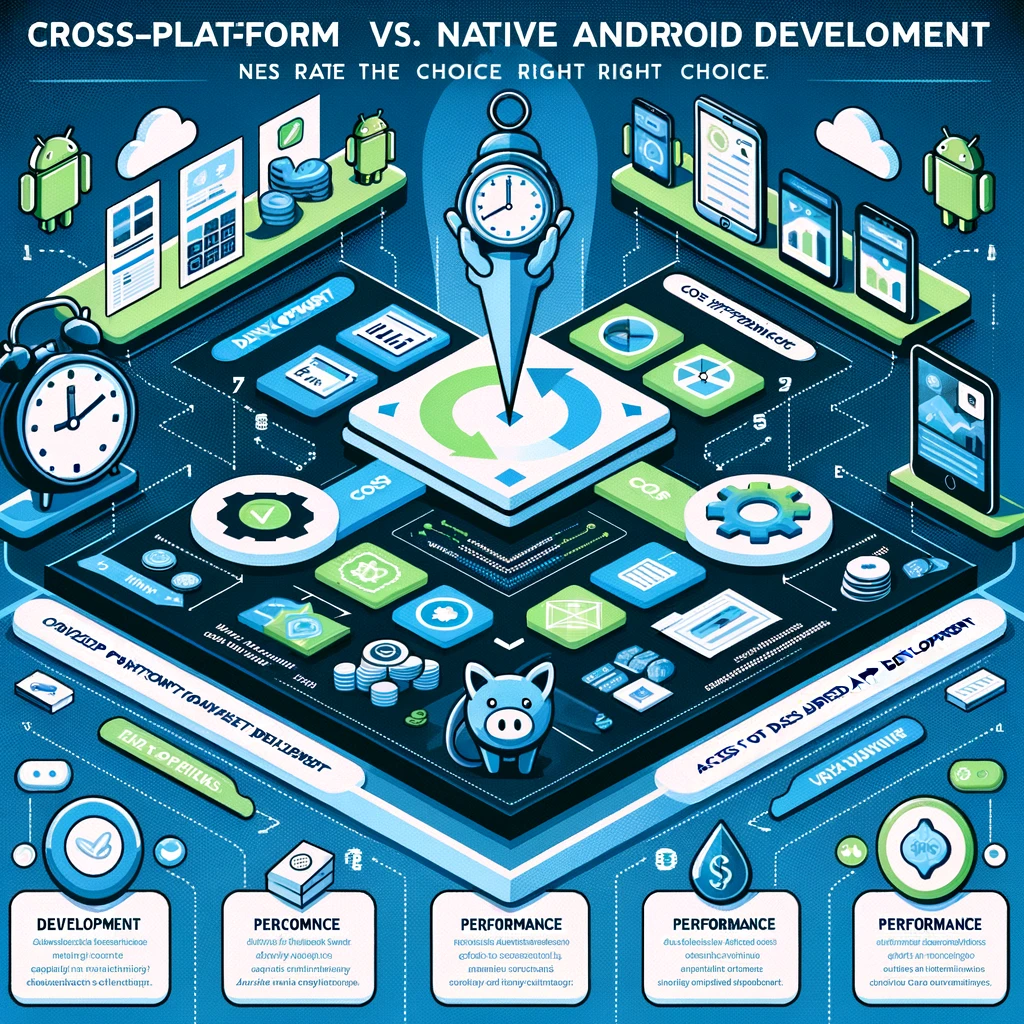The Choice Between Cross-Platform Approach and Native Development on Android
Application development

 295
295 
Application Development: The Choice Between Cross-Platform Approach and Native Development on Android
With the staggering increase in smartphone usage and the expansion of the application market, application development has become a central and sought-after field more than ever. Mobile developers are now required to make important strategic decisions early on, with one of the most significant choices being between Cross-Platform Development (CPD) and Native Development specifically tailored for the Android operating system.
While cross-platform application development allows for a single codebase that can run on a wide variety of operating systems, native application development focuses on a single system and leverages its full potential and unique capabilities. Each approach has its own benefits and drawbacks, and the choice between them depends on a variety of factors—from project goals to budget and time constraints, to the team's technology preferences.
Cross-Platform Application Development (CPD)
Advantages:- Rapid and Efficient Development: Developing applications using the CPD approach allows writing a single codebase that can run across multiple platforms, saving time and valuable resources compared to writing separate code for each system.
- Simple Maintenance: Updates and fixes are done in one place and updated across all platforms, significantly simplifying and speeding up the development and testing processes.
- Wider Audience Reach: Developing applications using CPD allows reaching a broader audience by making the app accessible on various operating systems, without investing additional resources in dedicated development for each platform.
- Limited Performance: Apps developed using the CPD approach may exhibit slower performance or lower responsiveness compared to native apps, due to reliance on intermediary software components.
- Partial Access to Unique Features: CPD does not always allow for full utilization of the capabilities and functionalities of every operating system, which may limit the app's potential.
- Inconsistent User Interface Design: CPD apps may show inconsistency in the user interface and feel "foreign" compared to native apps, which could negatively impact the user experience.
- Flutter
- React Native
- Xamarin
Native Application Development for Android
Advantages:- Excellent Performance: Developing applications with the native approach maximizes the potential of the Android operating system, optimally utilizing the hardware and software capabilities, leading to a fast, smooth, and responsive user experience.
- Full Access to Unique Features: Native development for Android gives developers complete control over all aspects and components of the system, including sensors, camera, location, communication, and more—without limitations.
- Consistent and Intuitive Interface Design: Native applications fully comply with the accepted design guidelines and styles in the Android system, providing users with a natural, familiar, and easy-to-use experience.
- Long Development Time and High Costs: Developing applications using the native approach requires a greater investment of time and resources, as separate code must be written and maintained for each platform.
- Complex Maintenance: Making changes and updates to the application requires handling each system separately, which burdens development processes and extends time to market.
- Limited Audience Reach: Native apps are limited to users of the specific operating system (in this case, Android), thus losing the ability to reach a broader audience on other systems.
- Android Studio
- Kotlin
Statistics and Data
Some interesting data that can assist in making an informed decision:
- According to Statista (2023), the cross-platform application development market is expected to grow by approximately 28% by 2025, indicating an upward trend in demand for such solutions.
- A study by Appinventiv (2022) found that around 40% of developers currently use popular cross-platform development platforms like Flutter and React Native.
- Sensor Tower data (2021) shows that native applications are responsible for about 70% of total revenue in the global app market, a testament to their high economic potential.
- AppsFlyer (2023) reported that user satisfaction with native apps is 1.7 times higher compared to apps developed using the cross-platform method.
In Conclusion
The choice between cross-platform application development and native development for Android is a complex but critical decision that has a decisive impact on the future of the project. While the CPD approach is more suitable for situations requiring a shorter development time, limited budget, or the desire to reach wide audiences across various platforms, the native approach prioritizes performance, optimal user experience, and full utilization of Android system capabilities.
Ultimately, there is no magic formula or universal answer. The decision should be made based on the full range of relevant considerations for each case—from business goals and project objectives to the type of application and required features, down to time, budget, and resource constraints.
Our recommendation for developers and teams involved in application development is to seriously consider the advantages and disadvantages of each approach, deeply understand the implications of each choice, and utilize objective data alongside their intimate understanding of the project's needs and the team's capabilities. A combination of knowledge, experience, and intuition will ultimately lead to the best decision.
Remember, your initial choice may not necessarily be final or irreversible. It is always possible to combine approaches or switch from one to another as the project evolves and requirements change. What matters is to remain flexible, open to innovations, and driven by the desire to deliver the best possible application for your users, on whatever platform you choose.


